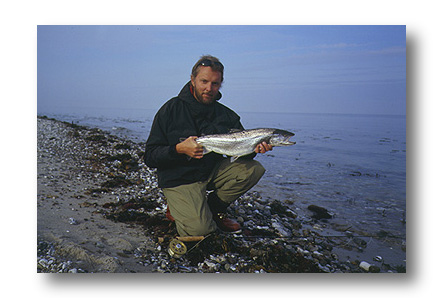|
They may even have been as far as the Davis
Strait between Greenland and Canada. They may have been en route
for two or three years, which means a few extra kilos in the
luggage by the time they return home!

- Silvery seatrout caught
on a Christmas tree fly in saltwater.
- © photo: Steen
Ulnits
Rivers
These "Easter salmon" lure salmon
fishermen to rivers like the River Guden year after year - maybe
to a visit to the classical salmon pools near Frisenvold. However,
most of them are severely disappointed, which is a real confirmation
of the meaning of "April Fools"!
The first May flies of the year - the fly-fisher's
"Large Dark Olives" and the Baëtis rhodani of
the entomologist - typically hatch on warm days in April. This
becomes the first surface meal of the year for the trout and
grayling of the river - the latter in its spawning season and
consequently preserved.
So now is the time to get the first dry
flies out of the fly box. Old steadies that have been there for
years, and which may have been given a touch-up over a steaming
kettle in the kitchen. Or completely fresh ones that were tied
during the long winter evenings. Flies that have fed the imagination
of the dry fly angler, who by now has had to do without the river
for months.
Lakes
April is also the month when perch, heavy
with roe, arrive at the spawning grounds. Here they spawn in
long chains on the water plants, which will later provide good
protection to the young, unless the tenant of the lake wants
to thin out the stock. If so, he may have thrown a number of
rice vases or old Christmas trees into the water and anchored
them there.
The lake perch finds such artificial spawning
grounds absolutely enticing and will immediately spawn there
- almost to order - with the desired result that the tenant of
the lake can then pull the roe-covered rice vases or Christmas
trees out of the water again.
Ocean
The long-billed garfish typically arrives
towards the end of April. The first ones are always the biggest
- about a metre long and as thick as a wrist before the breeding
that will really do something to the weight they gained during
their winter stay in the North Sea.
Along the coast, the silvery sea trout
is truly in its element. Those that were breeding in winter are
gradually regaining their lost weight. At any rate, the water
temperature is now so high that the fish can hunt actively all
day. And the water is now full of all kinds of small fry, crustaceans
and bristle worms.
And the sea trout that have spent the winter
in the rivers or the brackish fjords can now move out to more
open and salty water. Here in April there is a massive movement
of sea trout from many closed fjord areas to the open coastal
areas, where the fish will later spread out all through the summer.
Out here on the open coast they can stuff
themselves with the shoals of sand eel, sprat and herring. In
no time they can grow much bigger than they would have been able
to do in the fjords, where the majority of the feed is made up
of sticklebacks, gobies, shrimps and sand-hoppers.
The coastal waters now have a temperature
that really suits the cod and it can be seen very close to the
shore, where it hunts for its favourite food - crunchy crabs.
The best time for spotting it is the hours just before and just
after sunset.
© Steen Ulnits
|

